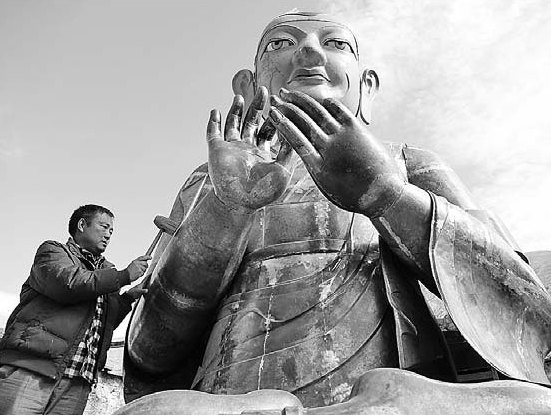This is a gorgeous statue of Lama Tsongkhapa. I just wanted to share this article here because it explains that the statue makers are not commercially motivated but their craft is purely for religious purposes. Also i am happy to see that it is still very much an artist's craft - with apprentices. Apprenticeship is pretty rare in the West nowadays, with mass production being the norm today.
Bronze sculptures continue to shineUpdated: 2013-04-02 07:50 By Palden Nyima ( China Daily)
http://www.chinadaily.com.cn/cndy/2013-04/02/content_16367295.htm The 5.7-meter-high bronze statue of Je Tsongkhapa, founder of the Gelukpa school of Tibetan Buddhism, was created by Migmar Losang, Thubten Tsering and 26 apprentices. Daqiong / China Daily
The 5.7-meter-high bronze statue of Je Tsongkhapa, founder of the Gelukpa school of Tibetan Buddhism, was created by Migmar Losang, Thubten Tsering and 26 apprentices. Daqiong / China Daily
On a cold day in February, master Tibetan bronze sculptor Migmar Losang and 26 apprentices were busy working on a 5.7-meter-high statue.
"It's of Je Tsongkhapa, founder of the Gelukpa school of Tibetan Buddhism," says Migmar Losang, who operates a bronze workshop with his brother Thubten Tsering.
"We will spend 45 days to complete the work ordered by the Olkha Rdzingchi Monastery in Lhokha prefecture."
The workshop is in the remote mountain valley of Palnag in Daktse county about 25 km from Lhasa.
Migmar Losang, 41, and his brother have been running the workshop for more than a decade.
Bronze statues are an important aspect of traditional Tibetan crafts.
The apprentices are from many places in Tibet, aged between 16 and 48.
"Our workshop began operation in 2002. It takes at least 10 years to be a qualified sculptor - some become skilled quicker because they are smart and diligent, but others are slower," Migmar Losang says.
He says that old techniques have been modernized with wood frames replaced by steel, scissors by electric clippers in the design process, and zinc welding with oxygen welding.
"This statue can be finished five days faster than the old way," Migmar Losang says.
Thubten Tsering is also an experienced craftsman. His fondness for photography allows him to be more innovative in his job.
He visited many monasteries in Tibet to take pictures of Buddha statues.
Back home, he uses a computer to modify the pictures into 3D images that can be used in the design.
It is a rare skill among his fellow craftsmen, but he has no intention of keeping it a business secret.
"Building statues is for the benefit of all Buddhists," Thubten Tsering says. "I don't do the job for the sake of business."
Migmar Losang's workshop is viewed by local craftsmen as one of the best in the village because of its good pay and accommodation.
Tenzin Kelzang, who is in his seventh-year of apprenticeship under Migmar Losang, admits that he is "not skilled, so I don't get a high salary."
"But I enjoy my job here. I want to inherit this unique craft," he says.
Thubten Tsering explains that "the most skilled worker earns 6,000 yuan ($965) a month and a new apprentice gets around 1,500 yuan".
"We help the youngsters save money, preventing them from wasting all their salary without handing it to their parents."
He says most orders come from U-Tsang in the central region of Tibet and Kham, which covers the eastern part of the autonomous region and western Sichuan province.
"No contracts are signed for orders as negotiations are done with lamas, who are considered supreme spiritual teachers by Tibetans, so trust plays the key role," Thubten Tsering says.
A recent commission was a 23-meter-high Buddha statue ordered by a lama from a monastery in Lhokha. The work took three years to complete.
Among the 11 bronze workshops in Palnag village, only two are run by locals. The rest moved to the area in the 1960s from Chamdo prefecture in eastern Tibet, an area famous for its bronzes.
Most artisans in Palnag - including Migmar Losang - were students of the old Chamdo masters.
Chimed Sengge, 85, also from Chamdo, is the master craftsman who taught all the bronze smiths in Daktse county.
He has been in the trade for about 60 years. He learned it from his father and became an independent craftsman at the age of 35. He has trained about 40 of the sculptors, with 16 becoming workshop owners.
"I began my apprenticeship at 13. I learned to make statues using bronze, silver and gold," Chimed Sengge says.
"In the old days, we used zinc welding and tools like scissors and hammers. Today people use oxygen welding, advanced tools and even computers - things that make the job easier, more efficient and innovative."
Chimed Sengge retired in 2003 when he was 75 years old. But he still owns his workshop.
He noted the latest efforts of local authorities in protecting the traditions of his craft.
In 2010, his workshop was included in the autonomous region's list of protected intangible cultural heritage.
"It's crucial that this asset can be passed down to the next generations," says Manlha Tsering, the son of Chimed Sengge.